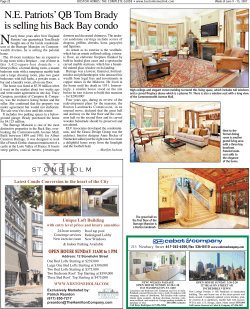
How to write an IB Physics Lab Report Example Lab
a Ex m e pl How to write an IB Physics Lab Report ...write it to meet the IB requirements! P(a) P(b) Dc Dp CE Lab Book (DC) Pa Pb Dp CE are a separate report with cover sheet Italicized comments below refer to my evaluation of the lab report presented here. This report does NOT represent a “perfect report” For a more detailed P(a) see the file 0_0_IB_Pa_labs_Q1.pdf Problem Statement: What are the motion characteristics of a “marble” launched thru a plastic tube? This cannot just be a re-statement of the “aim” provided by the teacher. P(a) Hypothesis: The motion characteristics of a launched marble can be completely described by studying the initial horizontal launched velocity and the resulting acceleration of the marble. The height of the tube will affect the exit (horizontal) velocity. The exit velocity along with “g” = 9.81 m/s2 will affect the motion characteristics. IB Lab Writing 802 1 Note how this relates the hypothesis (or prediction) to the research question and discusses some quantitative expectations. Variables: What are the ‘constant’ or non changing for each trial? (controlled) What variable will be changed or manipulated from trial to trial? (independent) - height of the tube (the varied or changed variable) - same marble -same tube material -same drop sequence and procedure -same room temperature “g” = 9.81 m/s2 ... Lets assume that for this experiment we will keep all variables the same except for the height of the tube and see how velocity is affected. E m a x pl e IB Lab Writing 802 2 Note that you must clearly articulate what variables you are interested in and which ones will remain constant from one trial to another. You cannot change more than one variable at a time. P(b) Method Tubes of various lengths (height) will be used. (tubes of the same material) The same marble will be used in each run A motion detector will be used to measure the exit velocity A cardboard launch mechanism will be employed to ensure the marble is always dropped in the ‘same way’. tape measure tubes of various heights Appropriate measuring tools have been selected here. A tape measure and a motion detector. Keeping the same marble and employing the cardboard launch mechanism allow for the control of the variables. A diagram is VERY important in this section! Motion detector A cardboard ‘shutter’ will be used to ensure the marble is always dropped the same way in each trial. The procedure is to set up the tube assemble and shutter as shown, start up the motion detector software, pull the shutter to release the marble and then analyze the motion detector graph to determine the exit speed of the marble. Repeat each drop 3 to five times at various heights. By repeating the trials at various heights sufficient relevant data should be collected. a x E IB Lab Writing 802 3 m pl e Dc Labbook entry Date: Oct 1, 2001 Note that this particular section (Dc) belongs in your bound lab book! Marble velocity lab Data: marble characteristics: green snake eye, radius= 0.5 cm, mass = 45 grams room temp: 22 ˚C ± 0.5 ˚C Trial 1 2 3 4 5 Drop Height velocity ave (cm) (cm/s) 20 ± 0.5 2.8 ± 0.1 20 2.9 20 2.7 20 2.6 20 2.8 2.7 ± 0.1 6 7 8 9 10 30 30 30 30 30 3.1 3.4 3.2 3.1 3.0 11 12 13 14 15 40 40 40 40 40 3.7 3.8 3.7 3.9 3.8 a x E m pl 3.2 ± 0.1 The raw data is in a TABLE allowing for easy interpretation. 3.7 ± 0.1 e IB Lab Writing 802 Both qualitative (green snake eye marble) and quantitative data (drop height and velocity) are recorded. The measurement uncertainty in the drop height ( ± 0.5) and exit velocity (±0.1) are clearly associated with the measurement including the correct UNITS and SIGNIFICANT DIGITS) 4 Recording data without a table almost guarantees point loss! D(p) Drop Height ave vel cm ± .1 m/s Ex ± 10.0 2.3 ± 0.1 20.0 2.7 30.0 3.2 ± 0.1 40.0 3.7 50.0 3.9 60.0 4.0 ± 0.1 am p For data processing you need to clearly show how you processed calculated results from the raw data. Another table with the raw and processed data is helpful. le Marble Velocity vs height v e l c m / s ± 0 . 1 4.0 3.9 3.8 3.7 3.6 3.5 3.4 3.3 3.2 3.1 3.0 2.9 2.8 2.7 2.6 2.5 2.4 2.3 2.2 5.0 10.0 15.0 20.0 25.0 30.0 35.0 40.0 height (cm) ± 0.1 45.0 50.0 Graphs of data are the most common and easiest method of presenting your results. All graphs must be: • titled • axis labeled with units AND uncertainty If appropriate, “error bars” indicating the uncertainty in the graph. For this graph the uncertainty in height ( ± 0.1 cm) is nearly impossible to see on the graph but the error in velocity is not. Hence an error bar of ±0.1 cm/s length is indicated in the vertical. In general, NEVER “connect the dots” on a graph. You must perform some sort of regression analysis. IB Lab Writing 802 5 55.0 60.0 Conclusion and evaluation As expected from the studies of motion, as the drop height increases, the horizontal exit velocity increases as a NON LINEAR function, possibly a square root function. This conclusion related the original problem statement and hypothesis to the data processing graph of a non linear function. v = 2 a ∆d As a check on the validity of this method for finding the velocity of the marble as it exits the tube the following was performed. Using a simple horizontal launch setup the predicted drop points were compared to the actual measured drop points. A further interpretation of the results is performed. Sometimes it is better to compare your results with accepted literature values. In that case you should always compare your results with literature values to find the error in your value as compared to the accepted value. predicted vs measured height (cm) predicted (cm) measured (cm) % error 10 20 30 IB Lab Writing 802 E m a x pl e 6 Conclusion and evaluation continued: The limitations and weaknesses in this lab were: • accurate method of measuring the velocity: The motion detector could not always “see” the small marble and missed the velocity. • consistent initial drop height: The drop mechanism would sometimes “sag” letting the marble drop from a slightly lower height than the top of the tube. • consistent tube height: The tubes would not always fit together consistently. • human error: The motion detector was not always started soon enough to catch the marble just as it exited the tube. The procedure needs to be evaluated here discussing (with details) the limitations, weaknesses and/ or errors in the lab. If your only error mentioned is “human” error you get zero points in this section. Suggestions to improve this lab are: Change the velocity detector alignment to ensure it always see’s the marble or look for a better detector. Build a more rigid launch mechanism to prevent sagging. Use single piece tubes if available. These suggestions MUST relate to the weaknesses or errors described above. Unrealistic or simplistic suggestions are not acceptable. Rewrite the procedure so that the detector is turned on before the marble is launched. a x E IB Lab Writing 802 7 m pl e
© Copyright 2025



















